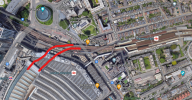Potentially bonkers suggestion here. Would it be possible to build a 2 or 4 track connection from Waterloo to Waterloo East, so that trains could come in to Waterloo then out via London Bridge in order to simplify operations in central London and avoid conflicting train movements from needing to reverse so many trains at these big termini?
This has been suggested before on these pages, and also by an individual / group who evidently had some crayons. I forget exactly what I said back then, but the headlines are:
1) yes it‘s possible - with extensive local disruption (ie demolition) and some rather significant rail dispruption to build it (ie years of engineering works on both routes, very probably with reduced service levels for months at a time)
2) what benefit does it bring?
3) the levels of service into Charing Cross and Waterloo don’t match, so that means having a proportion of the services into one or both terminii using the link, and another proportion continuing to the terminii. (As Charing Cross has fewer, it’s assumed that all the Charing Cross services would go to the Waterloo lines). That means grade separation and more lines on the immediate approach to Waterloo, to split out those that are using the link from those that aren’t.
4) it wouldn’t increase capacity
5) it would reduce journey times, marginally, for the people who currently make the connection by foot
6) it would extend journey times, substantially for the (far higher) number of people who usually travel to Charing Cross from the south east, and for that matter into Charing Cross from the lines into Waterloo.
7) It would cost billions.


